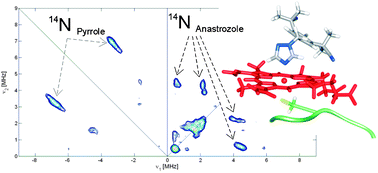Direct spectroscopic evidence for binding of anastrozole to the iron heme of human aromatase. Peering into the mechanism of aromatase inhibition†
Abstract
Aromatase (CYP19A1), is a microsomal cytochrome P450 catalysing the conversion of

* Corresponding authors
a
Dipartimento di Chimica IFM, Università di Torino and NIS, Nanostructured Interfaces and Surfaces Centre of Excellence, Via P. Giuria 7, I-10125 Torino, Italy
E-mail:
m.chiesa@unito.it
b Dipartimento di Biologia Animale e dell'Uomo, Università di Torino, Via Accademia Albertina 13, Torino, Italy
c University of Antwerp, Department of Physics, Universiteitsplein 1, B-2610 Wilrijk-Antwerp, Belgium
Aromatase (CYP19A1), is a microsomal cytochrome P450 catalysing the conversion of

 Please wait while we load your content...
Something went wrong. Try again?
Please wait while we load your content...
Something went wrong. Try again?
S. Maurelli, M. Chiesa, E. Giamello, G. Di Nardo, V. E. V. Ferrero, G. Gilardi and S. Van Doorslaer, Chem. Commun., 2011, 47, 10737 DOI: 10.1039/C1CC13872C
To request permission to reproduce material from this article, please go to the Copyright Clearance Center request page.
If you are an author contributing to an RSC publication, you do not need to request permission provided correct acknowledgement is given.
If you are the author of this article, you do not need to request permission to reproduce figures and diagrams provided correct acknowledgement is given. If you want to reproduce the whole article in a third-party publication (excluding your thesis/dissertation for which permission is not required) please go to the Copyright Clearance Center request page.
Read more about how to correctly acknowledge RSC content.
 Fetching data from CrossRef.
Fetching data from CrossRef.
This may take some time to load.
Loading related content
